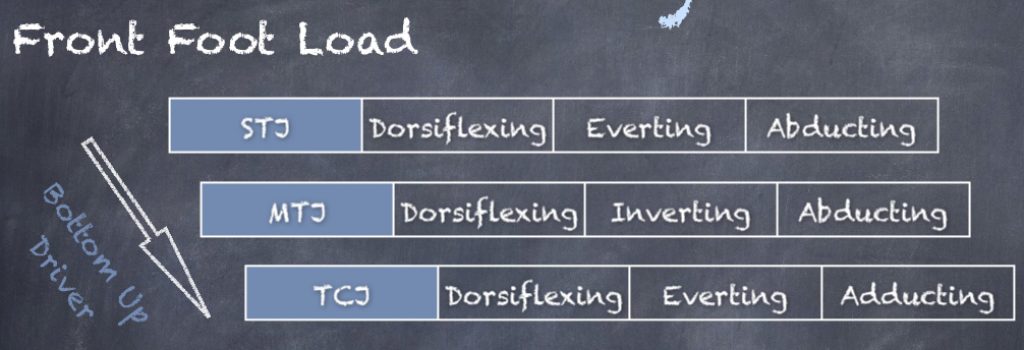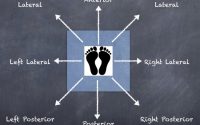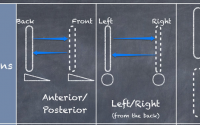Foot Mechanics in Gait – Part 2: The Front Foot
Foot Mechanics in Gait – Part 2: The Front Foot…Not the catchiest title I’ve ever written!! However, in a follow-up to last weeks post ‘Foot Mechanics in Gait‘ I wanted to get a bit more in depth. Partly because even though last weeks post was 1000 words it was still very much a skim over information and there is so much more to be taken from what starts out as a simple process of front foot and back foot motions!
So, what was missing from the last post? Well, we went through all the joint motions, so it would seem there is nothing left…however, we missed a step. You can’t have joint feelings without bone motions and though I did mention them, the real gains are in the details.
Foot Mechanics in Gait – The Front Foot: Setting the Scene
For Foot Mechanics in Gait, The Front Foot we need to understand gait. The gait cycle should flow nicely from one step to the next with previous motions of each limb assisting in the success of the other. We’ll be talking about the right foot here, starting with the point the heel hits the ground. The motion of the joints is driven from the ground up. As a result we will go through joint by joint in the order they feel their motion. It starts with the heel coming into the ground on the lateral side of the calcaneus…
Sub-Talar Joint
The STJ is made up of the calcaneus (distal bone) and the talus (proximal bone) and will be the first joint to feel motion after the calcaneus hits the ground. The contact with the ground will be with the lateral condyle of the calcaneus, which means the next thing to happen will be to get the medial condyle of the calcaneus on the ground. This is achieved by the calcaneus tilting to the left (remember it is a right foot). As the proximal talus will simply follow in the frontal plane it too will tilt left, but slower, giving you eversion, both bones tilting left distal faster.
The contact with the ground causes ground reaction force to travel up the leg, however there is also a frictional force that will stop the calcaneus moving anteriorly. A combination of the foot absorbing the GRF and the leg trying to come over the foot will cause the calcaneus to anteriorly tilt. The talus relatively less restrained will be able to translate forward more and will anteriorly rotate more, giving you dorsiflexion…both bones anteriorly rotating, proximal faster.
The transverse motion comes about partly due to the STJ axis linking frontal and transverse plane motion. I don’t think it’s a 1:1 ratio as has been talked about in the past, but the frontal plane eversion will cause the talus to rotate to the left and with the calcaneus relatively fixed by the ground. The resulting transverse plane motion will be external rotation (or abduction) both bones moving in opposite directions.
STJ Summary
- Sagittal Plane – Dorsiflexion – both bones anteriorly tilting, proximal faster
- Frontal Plane – Eversion – both bones tilting left distal faster
- Transverse Plane – External rotation – both bones moving in opposite directions

Talo-Crural Joint
We already know a fair bit about what the distal bone of the TCJ will be doing (the talus) as we’ve discussed it with the STJ. We also know that being a very congruent joint the proximal part of the joint (the tib and fib) will follow the talus, however, because the force is from below the talus is likely to move faster (though not always!).
In the sagittal plane, with the foot now flat on the floor and the lower leg now coming over the foot, the proximal bones will be anteriorly tilting over the top of the talus giving you dorsiflexion; both bones anteriorly tilting, proximal faster.
In the frontal plane we know the talus is tilting to the left and the tib/fib will be following along for the ride, just slightly behind, which means the TCJ will feel eversion; both bones tilting left, distal faster.
The transverse plane pretty straight forward too, the talus is rotating to the left and the tib/fib will be triggered to rotate left also. Since the tib/fib will be following it will rotate left slower than the talus giving you internal rotation (or adduction); both bones rotating left, distal faster.
TCJ Summary
- Sagittal Plane – Dorsiflexion – both bones anteriorly tilting, proximal faster
- Frontal Plane – Eversion – both bones tilting left distal faster
- Transverse Plane – Internal rotation – both bones rotating left, distal faster

Mid-Tarsal Joint
The MTJ has two parts to the joint, the talo-navicular joint and the calcaneo-cuboid joint. For now we will discuss as one joint split into rear foot and forefoot. The rear foot is the ‘proximal bone’ and the forefoot is the ‘distal bone’. With forefoot fixed to the ground (relatively) the rear foot motions will be the ones that drive the motion.
In the sagittal plane, the anterior tilt of the rear foot will posteriorly tilt the forefoot. This creates dorsiflexion; both bones moving in opposite directions. The left tilt of the rear foot will left tilt the forefoot as the foot pronates. As the rear foot moves further the MTJ will feel inversion. In the transverse plane the left rotation of the rear foot will drive the MTJ into abduction.
MTJ Summary
- Sagittal Plane – Dorsiflexion…both bones moving in opposite directions
- Frontal Plane – Inversion, both bones tilting left proximal faster
- Transverse Plane – Abduction…both bones moving in opposite directions

Finish
Foot Mechanics in Gait – The Front Foot…done!!
OK, that was a lot of detail!! Hope you were able to follow along 🙂
Phyisoblogger


